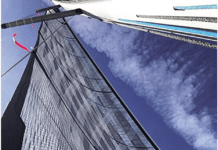NAVIGATION ADVICE
Regarding your recent blog post on navigating in poorly chartered waters, all of your tips, plus make use of the masses of very useful info available online. Like downloading satellite images as an addition to charts where nautical charts are unreliable or don’t exist. Search on youtube “How to Download Free Satellite Images,” featured in 2020 – Episode 113 “Sailing Luckyfish.” Sasplanet (gisenglish.geojamal. com) can also be a great way to get data from multiple sources, and also check if the datum of your charts is accurate, Opencpn (opencpn.org) does split screenshots. And there are online crowd sourcing nav sites like Navily (www.navily.com) and Noforeignland (www.noforeignland.com) that will often have much more recent info about harbours, than commercial or official guides
The Vestas grounding could have been avoided if they had not ignored their own written checklists, which included checking the intended route on Google Earth to make sure it was clear, plus have a downloaded copy of the Google satellite images onboard for checking along the way. If either of these hadn’t been ignored it’s very likely they would have been fine.
Paddy Burnside
Ebbtide 33
Currently in Portugal
PAPER VS. ELECTRONIC CHARTS
In my opinion, the paper vs. electronic chart debate is a red herring. At least for the United States, NOAA updates the electronic charts first (or at the same time for any critical updates). The problem is when people assume that navigational skills are no longer required, or when apps are put forward that lack basic functionality critical to safe navigation. I would hesitate to describe such skills and methods as “traditional” when in my mind they are still applicable and necessary in the electronic realm.
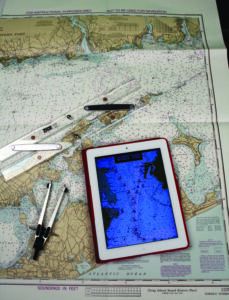
Good navigation requires a number of elements, including:
1. Reviewing the route for hazards. It’s poor practice to use only smallscale paper charts to check for hazards as part of pre-planning, so why would suddenly it become okay to do the equivalent—check the route while zoomed out—with electronic charts?
2. Not relying solely on GPS to fix position. As “the prudent mariner will not rely solely on any single aid to navigation”, why are people tolerating software that relies solely on GPS for positioning? Recreational apps that don’t allow you to plot a visual or radar fix are, in my opinion, inadequate for primary navigation. It’s akin to taking a paper chart but leaving behind compass and plotting tools.
3. Keeping charts up to date. NOAA pushes updates about every Thursday and I can pull them down at the press of a button. How many people are so diligent with their purple chart correcting pens? An SD card of indeterminate age in a plotter is little different from a stack of yellowed paper in this regard.
4. Awareness of, and accounting for,chart accuracy. Just as paper charts contain information about when and how different areas were surveyed, so too do electronic charts. Do users know how to access this information? Which apps even permit it?
On a related note, just this morning I happened across a rather detailed guide on electronic navigation systems from the Royal Institute of Navigation, written for the leisure market: https://rin.org.uk/page/ENav
In parallel they also produced a set of recommendations for manufacturers and official bodies regarding such systems: https://rin.org.uk/page/ ENavRec Jeremy Bishop San Francisco, CA
Excellent points. Ralph Naranjo’s April 2016 report, “In a Perfect Position to Fail,” which discusses a Zones of Confidence (ZOC) in NOAA charts, touches on many of the same topics.
USING A LIFESLING
Do you have to face forward when being towed in the Lifesling? Can you face backwards, or does that cause you to slip out? It seems facing backwards would prevent you from getting water in your face while being towed.
Andrew Inglis
Via PS Online
Ideally, the life sling is recovered at such a slow pace that water in the face is a minor issue. But we did test this with both the Lifesling and the Japanese DIY sling (See “In Search of the $50 Rescue Float,” January 2021). When facing forward, the harness must be around the middle of your back or side, or the tension will pull your head under. However once you slide it around, to your front, it can be a more comfortable way to be towed. This, from the Lifesline manual:
“The crew overboard may be more comfortable by rotating the Lifesling3 and floating on his or her back, but once alongside the boat, make sure he is facing the retrieval line. Maintain tension on the retrieval line so he will not slip out, and to reduce his immersion in the water and therefore his heat loss to the water.”
The sling must be rotated back before lifting. Remember to keep your arms down while being lifted,if you reach up to hold the rope or help board the boat, you can slip out.
If the crew wear chest harnesses or PFDs with a harness built in, it can be handy to keep a carabiner on 12-16- inch tether attached to the tow line to use for lifting. If the swimmer clips into this they cannot slip out of the Lifesling while being lifted, although the instruction to keep the arms down still applies unless the harness includes leg loops. Practical Sailor’s eBook, Man Overboard Prevention and Recovery (www.practical-sailor.com/products), covers these topics and more in greater detail.
JABSCO PUMP FLOW WOES
I have the Jabsco V-Flo onboard and as soon as the house bank dwindles to 12.4V, the sensor does not allow the pump to properly complete its charge of the system after the faucet is closed. Instead, it continues a very low speed cycling with no end. It is barely audible with any background noise and only serves to further drain the batteries. I think any system that is “smart” should be able to perform to 12V. Ours did not come with any panel described above for trouble shooting. Having to fire up a generator when the battery still has ample charge, just to keep the pump happy, is less than desirable.
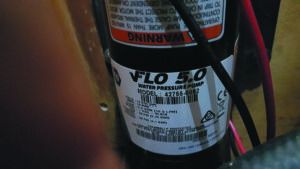
Will Kirkness
Vancouver, BC
This is not the first complaint we’ve heard about batteries being drained by malfunctioning water pump. If any other sailors have had this experience or a similar one, send details to the editor at [email protected].
COMPASS DELAY?
As a fellow contributor, I wanted to compliment you on a great article. I always like reading about the “latest and greatest.” My question/concern is about the SCX20’s ‘digital delay.’
Newbies and seasoned sailors are both subject to what aviators call spatial disorientation. We have both been there, no moon, 100 percent cloud cover and the only thing keeping you orientated is the card on the compass. With the classic compass, there is no delay—you turn the wheel, it spins. Also with a conventional magnetic heading sensor, there is no delay.
However, if one relies on COG calculated through the MFD, or worse a tablet, the delay can result in 360-degree turns. What is your opinion regarding the delay on the SCX20?
Bill Herrmann
Tartan 33
St. Petersburg, FL
In compass mode, set to zero damping, we experienced no delay with either the B&G Precision 9 or the Furuno SCX20 as the compass source. However, when displaying COG, set to zero damping, we experienced quite a bit of delay with our primary GPS, the B&G ZG100, or the SCX20 as the source. The delay is less with the SCX20. The delay in COG can certainly affect the helmsman steering, but it is responsive enough to prevent the spatial disorientation you describe. When a crew steers by the COG rather than compass, they will frequently oversteer, back and forth before settling on the course they want.
EPOXY PATCH VS. WATER
The common wisdom is that epoxy does not do well wet or underwater, in particular West System epoxies. I beg to differ. After rebuilding the cockpit of a Laser in our junior sailing program, including the delaminating around the scupper, less than 10 minutes later before the resin even started to warm up, the skies opened up.
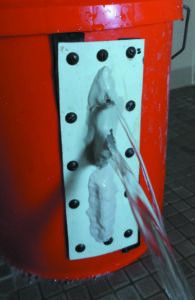
Within a short period of time the entire cockpit was full of water. What was I to do? Well, years later, that boat, sailed by an entire cast of intrepid young sailers, beat the heck out of it by torquing the hull in heavy winds with too many kids on board and capsizing it countless times because it is fun, and the repair continued to hold up well.
John Ghertner
Via PS Online
With spring launch season nearly upon us, it’s time to pare down that to-do list into manageable chunks. Whether you need antifouling paint or a new light-air sail, the PS archives have got you covered from top to bottom.
BOTTOM PREP
Ready to remove that layer cake of hard paint accumulated over the last decade? The blog post “Too Many Layers of Bottom Paint” includes links our most helpful reports on products and methods for removing paint. If all you need is new paint, the post also links to the top performers by region (see PS February 2014, “Favorite Bottom Paints by Region.”)
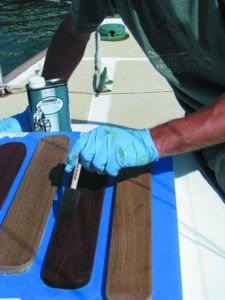
BRIGHT WORK
If wood finish is on your to-do-list, the archives are packed with useful tests and reports. If you’re removing an old finish or just touching up, the short blog post “Varnish Touch-ups and Take-downs” will point you in the right direction. For choosing a finish, a search under “varnish“ or “wood finish” on the Practical Sailor website will turn up multiple reports, including our most recent long-term test results (see PS July 2021, “Exterior Wood Finish Update at 2 Years”).
BOATYARD SAFETY
Safety comes first. But for many sailors who are intent on getting back into the water as soon as possible, this is often an afterthought. The blog post “Staying Safe in the Boatyard,” includes links to some of our most useful reports, including tips on ladder safety (falls are the most common boatyard injury), chemical safety (read that Safety Data Sheet!), and personal protective equipment (see PS September 2017, “The Best Respirators for the Boatyard”).
SAIL SHOPPING
In the market for a new mainsail or hardware? Don’t miss the August 2011 article on how to choose a new cruising main and the June 2013 review of mainsheet tackle. For hardware seekers, we recommend the test reports on ratchet blocks (May 2009), snatch blocks (August 2008 and August 2007), and rope clutches (March 2009, June 2009, and November 2014). In August 2009 we tested jib furlers, and in October 2015 we compared stanchion- mounted fairleads for roller furling gear. For a comprehensive look at everything from storm sails to cruising spinnakers check out our three-part ebook series, “A Look at Sails,” which is available at www.practical-sailor.com/products.















